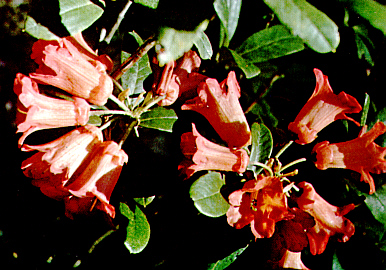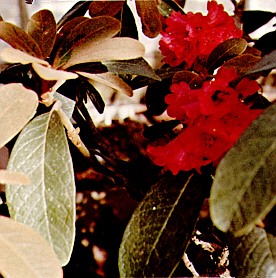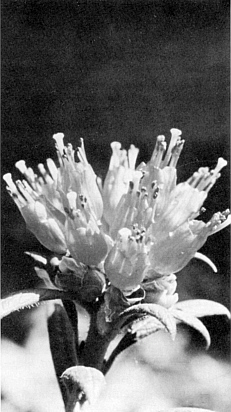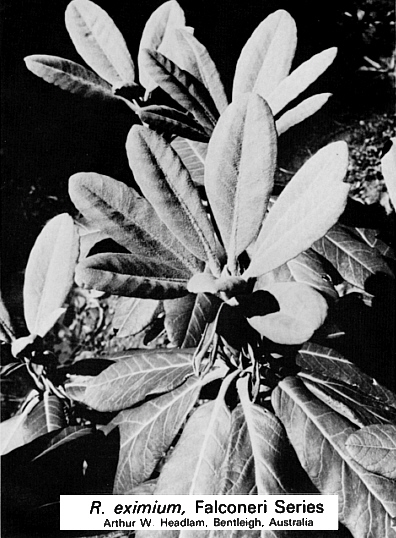Which Form is Finest?
Meldon Kraxberger, Portland, Oregon
So you have finally become, bewitched with rhododendron species and have decided to eliminate the dahlias and tulips, reduce the roses to three and landscape the backyard - with species. There is room for only the best. It will be a sort of sampler, cutting across the series lines to provide the utmost in variety. The names below are familiar ones; they belong to the most famous species; they are the most famous because they are, in some manner, the most distinctive. Choice will probably come mainly from these. But there is a joker in the deck
For the big, bold tropical look
R. calophytum
and
R. macabeanum
are the most dependable (there is larger foliage among more tender species). The Fortunei Series yields large, good-tempered shrubs for background or screening with really sumptuous flowers, and foliage better than laurel.
R. fargesii
is one of the first to bloom that looks like a rhododendron to most people.
R. decorum
is a fragrant beauty.
R. discolor
is even larger; the palest pink flowers in June permeate all the air around with an exotic scent.
R. orbiculare
has leaves like lily pads and rose pink trusses.
Most distinctive is the Thomsonii Series, medium-growing plants with rounded glaucous foliage. You may have difficulty choosing. Any or all of these three,
R. caloxanthum
,
R. campylocarpum
and
R. wardii
, will provide the best of the yellows. If this is your pet series, pink
R. souliei
and blood red
R. thomsonii
you must have. In time
R. thomsonii
will be the tallest; it develops a smooth peeling bark as it ages. Beloved
R. williamsianum
is dwarf with pink bells and round leaves. When in spring growth it appears briefly as if showered with new copper pennies. For frostiest blue foliage
R. campanulatum
var.
aeruginosum
and
R. lepidostylum
are the favorites.
The most fragrant rhododendrons are also the most tender; not for outside however desirable.
R. crassum
and
R. bullatum
are fairly hardy, white, and scented.
R. bullatum
wins with its rough puckered foliage, covered with white fuzz when new.
R. auriculatum
is very large, surprisingly hardy, and gives fragrant white flowers in August. Really good fragrance is in
R. occidentale
and
R. luteum
, both deciduous azaleas.
Neriiflorum Series means incandescent waxy reds to most growers. Five really good ones (but not the only five) are
R. neriiflorum
,
R. haematodes
, little
R. forrestii
var.
repens
,
R. didymum
, so red as to be almost black, and
R. dichroanthum
, not red at all but orange. In the sun the Triflorum series bloom exuberantly from top to bottom; the plants are lightly branched with willowy aromatic foliage.
R. augustinii
is the closest of all to true blue, and from all its various clones the closer to blue the better apparently.
R. davidsonianum
is pink, and
R. concinnum
is a vibrant deep magenta, something special with the sun behind it.

|

|
|
|
R. dichroanthum
(a Dr. Rock collection) Photo by Cecil Smith |
R. mallotum
Photo by Douglas W Johnson |
Specifically for indumentum there is the perfect
R. yakushimanum
,
R. bureavii
,
R. arboreum
and
R. mallotum
(not so hardy) wear fur underwear.
For filling in, edging or an ever changing carpet the Lapponicum, Anthopogon and Campylogynum Series are made to order. They are all small bushes with small incense-laden foliage and small but plentiful flowers; you can blend all shades of purple with white, yellow, pink and crimson. Winter bloom comes with
R. dauricum
, sometimes deepest orchid against the snow, and
R. mucronulatum
, larger, paler and a bit later.
There are others with special traits.
R. roxieanum
var.
oreonastes
has spiky foliage, looks like it might grow in a desert and certainly won't;
R. insigne
has a metallic luster beneath its shining leaves, those same beautiful leaves are your only reward for many years;
R. spinuliferum
has tangerine tubes for flowers;
R. leucaspis
, so small and early, has chaste white flowers and eyelashes around its leaves;
R. cinnabarinum
has grayish foliage and unique pendant-belled flowers of tawny red.
If you have played with an idea like this, you probably want the finest form available of each chosen species. The aforementioned joker is this. Within some species, individuals can range in garden value from mediocre to magnificent. But even with those species whose specimens are consistently good garden plants, if you have room to plant only one, it should be the best available.
While the English and American societies have rated the species as species, what of the fine selected clonal forms, of concern only to gardeners? Nowhere in rhododendron literature is there a list of the finest form, or forms of the various species; the reason why each is considered superior, and a description for identification purposes, of even the most widely grown clones. Another problem in the Northwest is that many clones of species are not what they are named.
As the plants in the Rhododendron Species Foundation grow to maturity some of the confusion will probably vanish. Should not the ARS and R. H. S. name and rate these finest forms of species in a simple easy-to-use list? A beginning has certainly been made, but the information is too incomplete and scattered in many different books. Maybe one day you will know which form is finest and what named clone to ask for when you go shopping for rhododendrons.
|
|
R. eximium
, Falconeri Series, at Kenron Park in the Dandenong Ranges is a most attractive rhododendron, not only for its campanulate rose or pink tinted flowers, but for its magnificent appearance after the flowers have fallen and the new growth appears.
The foliage, somewhat resembling that of
R. falconeri
, is covered below with a cinnamon-colored indumentum, whilst the bronze young shoots and foliage of this species are attractively covered with a cinnamon colored tomentum. Shaded by the surrounding trees, the color persists well into the winter. Some shelter from the heat in summer has been found necessary as the new growth is somewhat sun tender.

